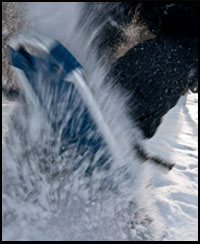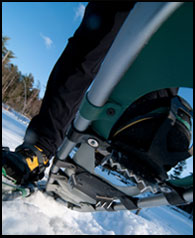| |
|
- Frames & Sizes
. . .
- In general there are three different
sizes of sport snowshoes commonly used: 8" x 25", 9" x 30" and 10"
x 36". Most sport snowshoes are symmetrical, where both sides are
identical and the foot is located on the center of the shoe. Asymmetrical
shoes are shaped according to the foot they are laced on, feet are
generally closer together, (off-center) and the tails may be cut
away to allow for high stepping or a running stride. All sport snowshoes
(or western shoes) will have turned up toes which make them easier
to move forward or downhill.
Traditional
snowshoes come in two different basic shapes: elongated teardrop
or oval.
Teardrop shapes tend to be long and narrow and have names such
as Yukon, Alaskan, Michigan or Maine snowshoes. Teardrops will
often have a large turned up toe. The Ojibwa shoe is similar to
the Alaskan shoe but with a pointed toe that is designed to cut
through deep powder easier. Oval shoes are called "bearpaws" and
are wider and shorter than the teardrop styles. The bearpaws will
sometimes have a small turn-up at the toe. Modified bearpaws, called
Green Mountain Bearpaws, are most popular due to their larger turned
up toe.
Bindings . . . - Traditional snowshoes are frequently
held on to your foot with neoprene or rawhide harnesses called either
"A" or "H" type bindings. "A" Style bindings mimic the more popular
sport snowshoe bindings while the "H" style bindings are the most
simple.
The more advanced
sport snowshoe bindings work in association with a hinging or pivoting
point on the snowshoe frame. The basic sport shoe models will be
fixed to the frame similar to their traditional cousins.
Features to look for
in bindings are durability, ease of use and secure positioning
of the foot.
Hinging vs. Fixed
Bindings . . . - The swing or forward
motion of a foot in a snowshoe binding is effected by the type
of pivot point or "hinge" that is designed into the shoe frame.
"Hinging" bindings have an axle that is attached to the sides of
the snowshoe frame which the binding is then attached to. These
types of bindings are frequently referred to as "free rotation"
or "rotational" bindings. Free rotation bindings allow the heel
of the snowshoe to drop freely from your foot and allow the front
of the shoe to rise up sharply shedding snow from the toe and tail.
"Fixed" bindings are bindings that are attached to the snowshoe
framework with stout rubber or plastic straps or decking. Fixed
bindings are often referred to as "non-rotating" or "stationary"
bindings. Fixed bindings are ideal for packed trails and runners
because they prevent the snowshoe tail from dropping away from
the foot as the foot rises from the snow. Fixed bindings can be
more maneuverable in tight areas.
Crampons & Claws . . . - All sport snowshoes come equipped with
some type of crampon or claw. These provide traction on icy or crusty
surfaces and are necessary on steep terrain for both ascending and
descending. Long serrated teeth are frequently added along the length
of the frame to provide stability while traversing.
Which One Should I Buy? . .
. - What type of snowshoeing
will you be doing and where will you be doing it? How much do you
weigh, and how much will your pack weigh while snowshoeing? How
much does the snowshoe weigh and how is it shaped? Most specialty
outdoor stores will have charts on recommended snowshoe sizes by
load weight. Discuss with the sales person your interests and requirements.
|
|


